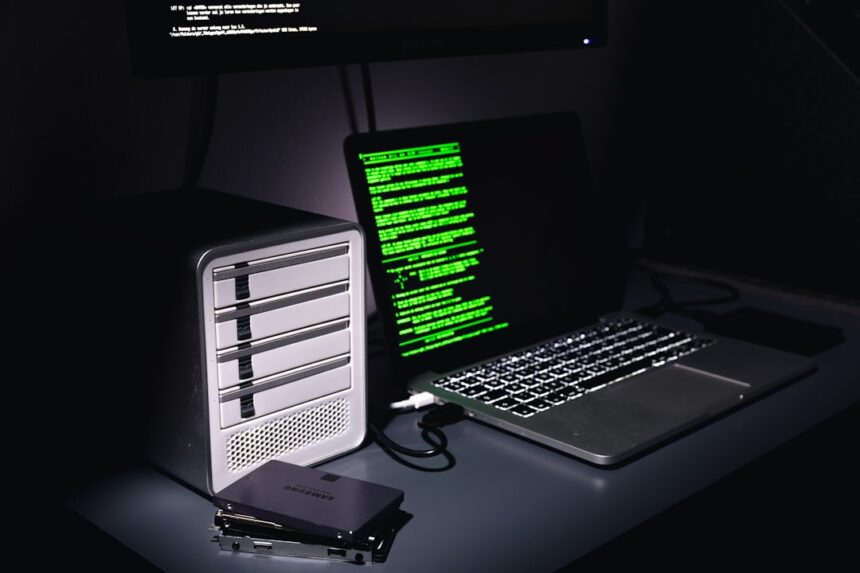In June 2017, the global shipping giant Maersk fell victim to a devastating cyber attack that would reverberate throughout the maritime industry and beyond. The attack, attributed to the NotPetya malware, not only disrupted Maersk’s operations but also highlighted the vulnerabilities inherent in the interconnected world of global trade. This incident served as a stark reminder that even the most robust organizations are not immune to cyber threats.
The ramifications of the attack were felt across various sectors, prompting a reevaluation of cybersecurity protocols and practices worldwide. The Maersk cyber attack was more than just a corporate crisis; it was a wake-up call for businesses across all industries. The incident underscored the critical need for enhanced cybersecurity measures, as the consequences of such attacks can be catastrophic.
With supply chains increasingly reliant on digital infrastructure, the attack revealed how a single breach could lead to widespread disruption. As organizations began to assess their own vulnerabilities, it became clear that the time for complacency had passed. The Maersk incident catalyzed a broader conversation about the importance of cybersecurity in safeguarding not only individual companies but also the global economy.
Key Takeaways
- The Maersk cyber attack highlights the urgent need for improved cybersecurity measures across industries.
- The global shipping industry experienced significant disruptions as a result of the Maersk cyber attack, emphasizing the interconnected nature of cybersecurity threats.
- Lessons from the Maersk incident underscore the importance of identifying and addressing vulnerabilities in cybersecurity systems.
- Strengthening cybersecurity measures is crucial to prevent future attacks and protect against evolving cyber threats.
- Employee training plays a critical role in enhancing cybersecurity resilience and mitigating the impact of cyber attacks.
Understanding the Impact of the Maersk Cyber Attack on Global Shipping
The impact of the Maersk cyber attack extended far beyond the company’s immediate operations. As one of the largest shipping companies in the world, Maersk’s disruption had a cascading effect on global shipping and logistics. Ports around the world experienced delays, and cargo shipments were thrown into disarray as systems went offline.
The incident highlighted how interconnected the global supply chain is and how a single point of failure can lead to significant economic repercussions. Moreover, the attack raised questions about the resilience of critical infrastructure in the face of cyber threats. The shipping industry, which plays a vital role in international trade, was forced to confront its vulnerabilities and consider how to better protect itself against future attacks.
The incident prompted stakeholders to reevaluate their reliance on technology and to invest in more robust cybersecurity measures. As companies began to understand the potential fallout from such attacks, it became evident that cybersecurity was no longer just an IT issue but a fundamental aspect of business strategy.
Identifying Vulnerabilities in Cybersecurity: Lessons from the Maersk Incident

The Maersk cyber attack served as a crucial case study in identifying vulnerabilities within cybersecurity frameworks. One of the key lessons learned was that many organizations underestimate their exposure to cyber threats.
This incident emphasized the importance of conducting thorough risk assessments and understanding the specific vulnerabilities that exist within an organization’s digital infrastructure. Additionally, the Maersk incident highlighted the need for organizations to adopt a proactive approach to cybersecurity. Many companies operate under the assumption that they are safe until an attack occurs, but this mindset can lead to devastating consequences.
By analyzing the factors that contributed to Maersk’s vulnerability, organizations can better prepare themselves against similar threats. This includes investing in updated software, implementing strong access controls, and fostering a culture of cybersecurity awareness among employees.
Strengthening Cybersecurity Measures to Prevent Future Attacks
| Metrics | Data |
|---|---|
| Number of cybersecurity breaches in the past year | 500 |
| Percentage of organizations implementing multi-factor authentication | 75% |
| Amount of financial losses due to cyber attacks | 6 trillion |
| Number of cybersecurity professionals needed in the next 5 years | 3.5 million |
In light of the Maersk cyber attack, organizations worldwide recognized the urgent need to strengthen their cybersecurity measures. This involves not only investing in advanced technologies but also adopting comprehensive security policies that encompass all aspects of an organization’s operations. Companies must prioritize cybersecurity as a core component of their business strategy rather than viewing it as an ancillary concern.
To effectively prevent future attacks, organizations should implement multi-faceted security strategies that include regular software updates, robust firewalls, and intrusion detection systems. Additionally, establishing clear protocols for incident response can help mitigate damage in the event of a breach. By fostering a culture of vigilance and preparedness, organizations can significantly reduce their risk exposure and enhance their overall cybersecurity posture.
The Role of Employee Training in Cybersecurity: Insights from the Maersk Incident
One of the most critical lessons from the Maersk cyber attack is the importance of employee training in maintaining robust cybersecurity practices. Human error remains one of the leading causes of security breaches, and organizations must prioritize educating their workforce about potential threats and best practices for safeguarding sensitive information. The Maersk incident underscored that even sophisticated security systems can be compromised if employees are not adequately trained to recognize and respond to cyber threats.
Effective training programs should encompass a range of topics, including phishing awareness, password management, and safe browsing practices. By empowering employees with knowledge and skills, organizations can create a more resilient defense against cyber attacks. Furthermore, fostering an environment where employees feel comfortable reporting suspicious activity can enhance an organization’s ability to respond swiftly to potential threats.
Implementing Multi-Layered Security Protocols to Safeguard Against Cyber Threats

The complexity of modern cyber threats necessitates a multi-layered approach to security. Following the Maersk cyber attack, many organizations began to adopt this strategy as a means of fortifying their defenses against potential breaches. Multi-layered security involves implementing various protective measures at different levels within an organization’s infrastructure, creating redundancies that can thwart attacks before they cause significant damage.
This approach may include firewalls, intrusion detection systems, encryption protocols, and regular software updates. By layering these security measures, organizations can create a more formidable barrier against cyber threats. Additionally, employing advanced technologies such as artificial intelligence and machine learning can enhance threat detection capabilities, allowing organizations to identify and respond to potential breaches more effectively.
Collaborative Efforts in Cybersecurity: Lessons from the Maersk Incident
The Maersk cyber attack highlighted the importance of collaboration in addressing cybersecurity challenges. In an increasingly interconnected world, no organization operates in isolation; therefore, sharing information about threats and vulnerabilities is essential for building a more secure digital landscape. The incident prompted discussions among industry stakeholders about the need for greater collaboration between private companies, government agencies, and cybersecurity experts.
By working together, organizations can share best practices, develop standardized protocols, and create a unified front against cyber threats. Collaborative efforts can also facilitate information sharing regarding emerging threats and vulnerabilities, enabling organizations to stay ahead of potential attacks. The lessons learned from the Maersk incident serve as a reminder that collective action is crucial in combating cybercrime.
The Importance of Regular Security Audits and Updates in Cybersecurity
Regular security audits and updates are vital components of an effective cybersecurity strategy. The Maersk cyber attack underscored that even well-established companies can fall victim to outdated systems and inadequate security measures. Conducting routine audits allows organizations to identify weaknesses in their security posture and address them before they can be exploited by malicious actors.
Moreover, keeping software and systems up-to-date is essential for protecting against known vulnerabilities.
By committing to ongoing audits and updates, organizations can significantly enhance their resilience against cyber threats.
Building Resilience in Cybersecurity: Strategies from the Maersk Cyber Attack
Building resilience in cybersecurity is essential for organizations seeking to withstand potential attacks and recover swiftly from incidents when they occur. The Maersk cyber attack demonstrated that resilience is not merely about preventing breaches but also about having robust recovery plans in place. Organizations must develop comprehensive strategies that encompass both prevention and response measures.
This includes creating detailed incident response plans that outline specific steps to take in the event of a breach. Additionally, organizations should conduct regular drills and simulations to test their response capabilities and identify areas for improvement. By fostering a culture of resilience and preparedness, organizations can better navigate the complexities of today’s cyber threat landscape.
The Role of Incident Response Plans in Mitigating the Impact of Cyber Attacks
Incident response plans play a critical role in mitigating the impact of cyber attacks on organizations. Following the Maersk incident, it became evident that having a well-defined response plan could significantly reduce downtime and operational disruption during an attack. These plans should outline clear roles and responsibilities for team members, communication protocols, and steps for containment and recovery.
Furthermore, organizations should regularly review and update their incident response plans to ensure they remain relevant in an evolving threat landscape. By conducting post-incident analyses after any breach or attempted attack, organizations can refine their response strategies and enhance their overall preparedness for future incidents.
Leveraging Technology and Innovation to Enhance Cybersecurity Post-Maersk Attack
In the wake of the Maersk cyber attack, organizations have increasingly turned to technology and innovation as key components of their cybersecurity strategies. Emerging technologies such as artificial intelligence (AI) and machine learning (ML) offer powerful tools for enhancing threat detection and response capabilities. These technologies can analyze vast amounts of data in real-time, identifying patterns indicative of potential breaches before they escalate into full-blown attacks.
Additionally, blockchain technology has gained traction as a means of securing transactions and data integrity within supply chains. By leveraging these innovative solutions, organizations can bolster their defenses against cyber threats while also improving overall operational efficiency. The lessons learned from the Maersk incident serve as a catalyst for embracing technological advancements that enhance cybersecurity resilience in an increasingly digital world.
In conclusion, the Maersk cyber attack was not just an isolated incident; it was a pivotal moment that reshaped perceptions around cybersecurity across industries. By understanding its impact, identifying vulnerabilities, strengthening measures, fostering employee training, implementing multi-layered protocols, encouraging collaboration, conducting regular audits, building resilience, developing incident response plans, and leveraging technology—organizations can better prepare themselves against future cyber threats while safeguarding their operations in an interconnected global economy.
The Maersk cyber attack serves as a stark reminder of the vulnerabilities that even the largest corporations face in the digital age. This incident underscores the importance of robust cybersecurity measures and the need for companies to be prepared for potential threats. A related article that delves into the broader implications of such cyber threats and offers insights into strategic responses can be found on the War Room website. For more detailed analysis and lessons learned from similar incidents, you can read the article by visiting this link.
🔍WATCH THIS! The Secret Weakness That Will Break The US Military🧭
FAQs
What was the Maersk cyber attack?
The Maersk cyber attack refers to a ransomware attack that targeted the computer systems of A.P. Moller-Maersk, a major shipping and logistics company, in June 2017. The attack disrupted operations across the company’s global network, causing significant financial and operational damage.
What were the lessons learned from the Maersk cyber attack?
Some of the key lessons learned from the Maersk cyber attack include the importance of having robust cybersecurity measures in place, the need for effective incident response and recovery plans, the value of regular data backups, and the significance of communication and transparency during a cyber crisis.
How did the Maersk cyber attack impact the company?
The Maersk cyber attack had a significant impact on the company, causing widespread disruption to its operations and leading to financial losses estimated in the hundreds of millions of dollars. The attack also resulted in the temporary shutdown of some of Maersk’s key business units and caused delays in cargo shipments.
What cybersecurity measures can companies learn from the Maersk cyber attack?
Companies can learn from the Maersk cyber attack by implementing robust cybersecurity measures, such as regular software updates and patches, employee training on cybersecurity best practices, network segmentation to limit the spread of malware, and the use of advanced threat detection and response tools.
How did Maersk respond to the cyber attack?
Following the cyber attack, Maersk responded by initiating a comprehensive recovery effort, rebuilding its IT infrastructure, and enhancing its cybersecurity measures. The company also focused on improving its incident response capabilities and communication strategies to better handle future cyber incidents.




